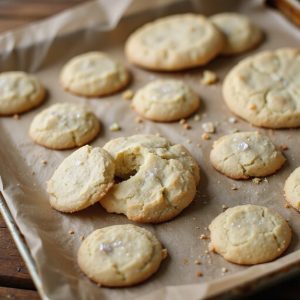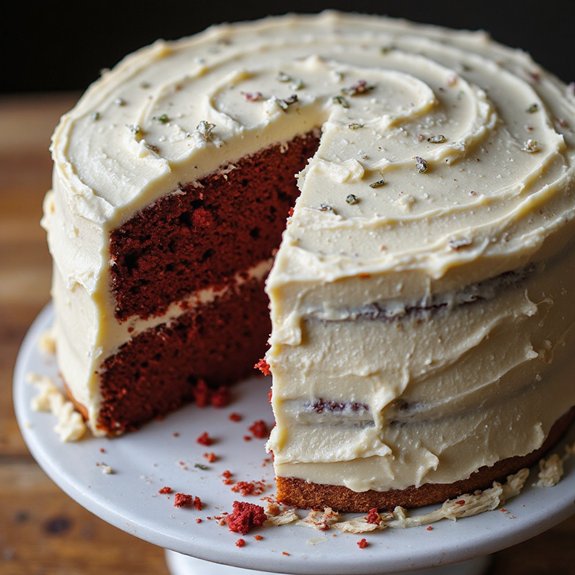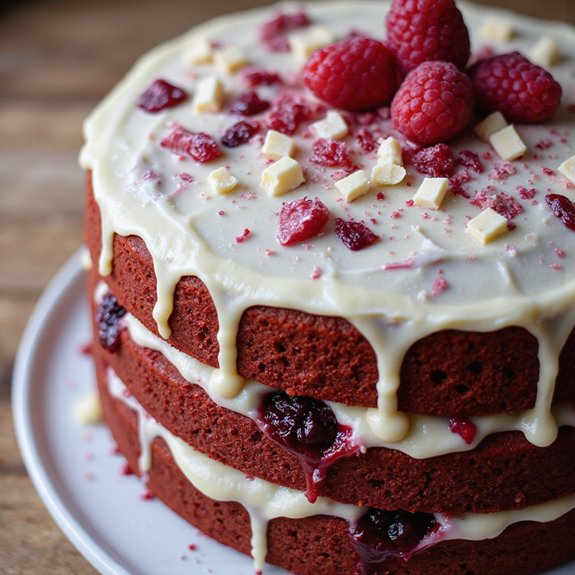Picture a tray of sugar cookies emerging from the oven—edges just set, centers pale and plush, a whisper of vanilla and butter wafting through the kitchen as fine sugar glints like fresh Chicago snow.
Their tender crumb gives way with the faintest crackle, a soft, sweet bite that feels like comfort you can hold. These are the bakery-style sugar cookies I grew up seeking out after school, the kind that make an ordinary day feel like a small celebration.
They’re perfect for busy weeknights when you need a quick treat, Sunday suppers that deserve a sweet finish, or last-minute gatherings where a classic always wins.
Once, a batch of these saved my nerves before a school bake sale—simple pantry ingredients, a short chill, and suddenly I’d dozens of crowd-pleasers cooling on the rack. You’ll love how reliably soft, fragrant, and shareable they are. Ready? Let’s cook!
Why You’ll Love It
- Delivers classic bakery-style softness with tender, melt-in-mouth crumb
- Uses pantry staples and simple, reliable techniques
- Offers versatile shapes: easy drops or clean-edged cut-outs
- Freezes beautifully, baked or unbaked, for anytime treats
- Balances vanilla richness with optional almond nuance
Ingredients
- 2 3/4 cups all-purpose flour — scoop and level for accuracy (use unbleached if possible)
- 1/2 teaspoon baking powder — fresh, not expired (check date)
- 1/2 teaspoon baking soda — guarantees spread and lift (store airtight)
- 1/2 teaspoon fine sea salt — balances sweetness (don’t omit)
- 1 cup unsalted butter softened — room temp for proper creaming (high-fat preferred)
- 1 1/4 cups granulated sugar — standard white sugar (fine grain helps)
- 1/4 cup powdered sugar sifted — for tender crumb (no lumps)
- 1 large egg room temperature — adds structure (bring to room temp)
- 1 large egg yolk room temperature — extra richness (separate cleanly)
- 2 teaspoons pure vanilla extract — quality matters (avoid imitation)
- 1/2 teaspoon almond extract optional — classic bakery note (use sparingly)
- 2 tablespoons whole milk room temperature — loosens dough (don’t over-add)
- 1/4 cup sanding sugar for rolling, optional — for sparkle and crunch (coarse crystal)
Step-by-Step Method
Cream the Butter and Sugars
Beat softened butter with granulated and powdered sugars until pale and fluffy, 2 to 3 minutes. Use medium speed to incorporate air for a tender crumb. Scrape the bowl as needed to make certain even mixing. Proper creaming helps the cookies stay soft and light.
Avoid overbeating, which can make them spread too much.
Whisk the Dry Ingredients
Combine flour, baking powder, baking soda, and fine sea salt in a bowl. Whisk until evenly blended with no streaks. This disperses leaveners for uniform lift. Set aside within reach.
Pre-mixing prevents overworking the dough later and keeps the cookie texture delicate. Keep the bowl dry to avoid clumping.
Blend in Eggs and Extracts
Add the egg, egg yolk, vanilla, and almond extract if using. Beat until smooth and glossy. The extra yolk provides richness and chew.
Make certain ingredients are at room temperature for seamless emulsification. Scrape the bowl to catch any pockets. Stop once homogeneous to avoid excessive aeration.
Loosen with Milk
Mix in the whole milk just until incorporated. Use low speed to avoid splashing and overmixing. The milk softens the dough slightly for a plush bite.
Don’t add extra liquid unless dough is overly stiff. A cohesive but pliable consistency is the goal before adding the dry mixture.
Combine Wet and Dry
Add the dry ingredients in two additions on low speed. Mix until a soft, cohesive dough forms with no dry patches. Avoid overmixing to prevent tough cookies.
Use a spatula to fold in any flour at the bottom or sides. The dough should feel smooth and slightly tacky, not sticky.
Chill to Set
Cover the dough and chill for 1 hour. Let the flavors develop and the butter firm up, which controls spread.
If the dough feels sticky after chilling, fold in 1 to 2 tablespoons flour. For extra-thick cookies, chill scooped portions an additional 20 minutes before baking.
Portion or Roll
For drop cookies, scoop 1 1/2-tablespoon portions and roll into balls. Optionally coat in sanding sugar.
For cut-outs, roll chilled dough to 1/4 inch between parchment for clean edges. Re-chill sheeted dough 10 minutes for sharper cuts. Use lightly floured tools to prevent sticking.
Arrange and Bake
Preheat the oven to 350°F (175°C) and line baking sheets with parchment. Space cookies 2 inches apart.
Bake 8 to 10 minutes until edges are set and tops look matte, not browned. Pull early for soft centers. Bake from cold dough for thicker, cakier results. Rotate pans if needed.
Cool and Finish
Let cookies rest on the sheet for 5 minutes to set structure. Transfer to a wire rack to cool completely.
Cooling prevents breakage and preserves tenderness. Add sprinkles or glaze if desired once fully cool. Store airtight at room temperature, or freeze baked cookies or dough balls for later.
Ingredient Swaps
- Dairy-free: Replace butter with plant-based butter sticks; swap milk with unsweetened oat or almond milk.
- Egg-free: Use 1/4 cup unsweetened applesauce or 1 flax egg (1 tbsp ground flax + 3 tbsp water) per egg; add 1–2 tbsp extra flour if dough seems sticky.
- Gluten-free: Use a 1:1 gluten-free all-purpose blend with xanthan gum; chill a bit longer to reduce spread.
- Nut-free: Omit almond extract; increase vanilla to 2 1/2–3 tsp or use 1/2 tsp lemon extract.
- Budget/availability: Use all granulated sugar (replace powdered sugar with 2 tbsp granulated); use vanilla essence if pure extract is pricey.
- Flavor swaps: Try 1/2 tsp lemon or orange extract, or 1/2 tsp vanilla bean paste for a bakery-style boost.
- Texture control: For less spread in humid climates, add 1–2 tbsp extra flour; for softer cookies, replace 2 tbsp flour with cornstarch.
You Must Know
Doneness • If tops look shiny and centers feel soft like a marshmallow when tapped at 8 minutes, give 1–2 more minutes; pull when surfaces are matte with just-set edges and no browning for a tender crumb.
Troubleshoot • If cookies spread into puddles by minute 6, chill portioned dough 20–30 minutes and add 1–2 tablespoons flour; butter may be too warm—aim for dough that feels cool and firm, not tacky.
Flavor Boost • For a classic bakery aroma, add 1/2 teaspoon vanilla bean paste or swap almond extract for 1/2 teaspoon lemon zest; you’ll smell a fragrant burst when opening the oven and taste brighter notes without extra sweetness.
Scale • For a half batch, use 1 egg white only (omit yolk) to keep structure balanced; for a double batch, weigh flour to 330 g per 2 3/4 cups and extend chilling to 90 minutes to prevent overspreading.
Make-Ahead • To streamline, portion dough and freeze solid on a sheet, then bag; bake from frozen adding 1–2 minutes, looking for the same matte top/just-set edge cue at around 10–12 minutes total.
Serving Tips
- Serve warm with cold milk or a scoop of vanilla ice cream.
- Pair with coffee or hot cocoa; add a pinch of cinnamon on top.
- Sandwich with frosting or jam for bakery-style cookie sandwiches.
- Plate with fresh berries and a dusting of powdered sugar.
- Crumble over yogurt or pudding for a quick dessert topping.
Storage & Make-Ahead
Store baked cookies airtight at room temperature 4–5 days or refrigerated up to 1 week.
Dough keeps covered in the fridge 2–3 days; let soften slightly before scooping or rolling.
Freeze options: dough balls or cutouts up to 2 months, baked cookies 2–3 months.
Bake frozen dough adding 1–2 minutes.
Reheating
Reheat gently: microwave 5–10 seconds per cookie, wrapped in a damp paper towel.
Oven at 300°F for 4–6 minutes on a sheet.
Stovetop: covered skillet, low heat, 1–2 minutes.
South Side Bake Sales
Although the lake wind can nip your fingers, I love walking a tin of warm Chicago sugar cookies into a South Side bake sale and watching faces light up.
The neighborhood tables bloom with school colors, yarn crafts, and foil-wrapped pans; my cookies slide right in like they belong. I keep them soft and pale—pulled at the first matte top—so they stay tender through the afternoon rush.
For a crowd, I double the batch, roll some in sparkling sanding sugar, and cut others clean for variety.
Label a few with “almond” or “lemon swap” so folks know what they’re grabbing. Pack them snug in parchment-lined tins, bring a cooling rack for quick rotations, and price fairly. You’ll sell out before the coffee cools.
Final Thoughts
Give these Chicago Sugar Cookies a try and see just how soft, buttery, and bakery-style they can be at home.
Tweak the extracts, toss in some citrus zest, or play with sanding sugar to make them your own!
Frequently Asked Questions
Can I Make These Cookies Gluten-Free Without Gritty Texture?
Yes. I’d swap in a quality 1:1 gluten‑free flour with xanthan gum, whisk in 1–2 tablespoons cornstarch, and chill well. I’ll underbake slightly for tender centers—no grit, just soft, cozy crumbs and fragrant vanilla.
How Do High-Altitude Adjustments Change Time and Temperature?
Increase oven temp by 15–25°F and shorten bake 1–2 minutes; dough sets faster in thin air. I’d add a tablespoon flour, watch matte tops, and pull early—soft centers settle like snowdrifts into tender, cozy crumbs.
What’s the Best Natural Food Coloring for Dough?
Use beet, turmeric, and spirulina powders; they tint dough beautifully without off-flavors. I blend beet with cocoa for rosy blush, turmeric with vanilla for sunshine, spirulina with mint for sea-glass green. Infuse gently; add moisture if dough tightens.
Can I Substitute Plant-Based Butter and Achieve Similar Spread?
Yes, you can, but choose a plant-based butter with at least 80% fat. I’d chill the dough longer, add 1–2 tablespoons flour if soft, and watch bake time—your cookies will still nestle into tender, cozy edges.
How Do I Prevent Cookies From Turning Too Brown?
Keep them pale by baking at 350°F until matte, not golden; I pull them early. Use light-colored sheets, parchment, and center rack. Chill dough, rotate pans, and tent with foil if edges darken. Cool on sheets briefly.

Chicago Sugar Cookies
Equipment
- 2 Mixing bowl
- 1 hand mixer or stand mixer
- 1 Whisk
- 1 Rubber spatula
- 1 measuring cup set
- 1 Measuring spoon set
- 2 Baking sheet
- 2 parchment paper sheet
- 1 wire cooling rack
- 1 Rolling Pin optional
- 2 Cookie cutter optional
- 1 Small bowl for sanding sugar, optional
Ingredients
- 2 3/4 cup all-purpose flour
- 1/2 teaspoon baking powder
- 1/2 teaspoon baking soda
- 1/2 teaspoon fine sea salt
- 1 cup unsalted butter softened
- 1 1/4 cup granulated sugar
- 1/4 cup powdered sugar sifted
- 1 large egg room temperature
- 1 large egg yolk room temperature
- 2 teaspoon pure vanilla extract
- 1/2 teaspoon almond extract optional
- 2 tablespoon whole milk room temperature
- 1/4 cup sanding sugar for rolling, optional
Instructions
- Preheat the oven to 350°F (175°C) and line baking sheets with parchment paper.
- Whisk flour, baking powder, baking soda, and salt in a medium bowl until evenly combined.
- Beat softened butter, granulated sugar, and powdered sugar with a mixer on medium speed until pale and fluffy, 2 to 3 minutes.
- Add the egg, egg yolk, vanilla extract, and almond extract if using, and beat until smooth and glossy.
- Mix in the milk just until incorporated to loosen the dough slightly.
- Add the dry ingredients to the wet ingredients in two additions, mixing on low until a soft, cohesive dough forms.
- Cover and chill the dough for 1 hour to firm up and develop flavor.
- For drop cookies, scoop 1 1/2-tablespoon portions, roll into balls, and, if desired, roll in sanding sugar.
- For cut-outs, roll chilled dough to 1/4-inch thickness on a lightly floured surface and cut with cookie cutters.
- Arrange cookies 2 inches apart on prepared sheets and bake 8 to 10 minutes until edges are set and tops look matte but not browned.
- Let cookies cool on the sheet for 5 minutes, then transfer to a wire rack to cool completely.





